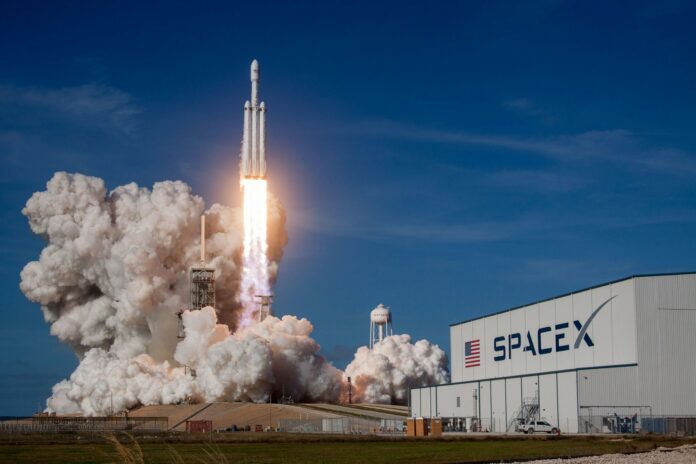The fourth test flight marks a milestone for SpaceX’s starship program with a splashdown landing in the Gulf of Mexico
SpaceX successfully completed the first-ever vertical landing of its Super Heavy booster during the fourth integrated test flight of the Starship rocket. This milestone marks a significant achievement in SpaceX’s ambitious space transportation program. The landing, which took place in the Gulf of Mexico, was initially broadcast live, though only onboard camera footage was available during the livestream.
Soon after, SpaceX released video footage from a tracking camera stationed in the Gulf, providing a clearer view of the landing manoeuvre. The video showcased the critical landing burn phase, during which the Super Heavy booster reignited 13 of its 33 Raptor engines to achieve a controlled descent and splashdown.
This successful landing follows a previous attempt during the third test flight, which encountered issues with fuel delivery to the Raptor engines, resulting in the loss of the booster approximately 460 meters above the Gulf of Mexico. However, SpaceX addressed these issues, leading to the flawless execution of the recent splashdown.
Landing on water serves as an interim step to test the Super Heavy’s landing capabilities before attempting landings on solid ground. SpaceX’s ultimate goal is to land the booster on the launch pad using massive steel “chopsticks” to catch it. This method, though risky for the ground infrastructure, will eventually enable rapid reusability of the space transportation system.
Elon Musk, SpaceX’s CEO, hinted at future plans on social media platform X, stating, “Next landing will be caught by the tower arms.” Achieving such high-precision landings on the Starbase launch pad in Boca Chica, Texas, is crucial for SpaceX’s vision of rapid reusability.
The success of this fourth test flight paves the way for the next test, which could occur within a few weeks. The Federal Aviation Administration (FAA) has no reason to investigate any mishaps from this flight, significantly reducing the time required to obtain a flight license for the subsequent launch.
This milestone represents a critical step in SpaceX’s journey to develop a fully reusable space transportation system. The Super Heavy booster, standing 71 meters (232 feet) tall and made of stainless steel, performed impressively during this test, demonstrating the viability of SpaceX’s ambitious plans.
As SpaceX continues to refine its technology and processes, the potential for rapid, reusable space travel becomes increasingly feasible. This achievement not only enhances SpaceX’s capabilities but also moves the space industry closer to more sustainable and cost-effective space exploration.
Analysis:
SpaceX’s successful vertical landing of the Super Heavy booster signifies a major advancement in aerospace engineering and space exploration. This achievement has wide-ranging implications across various perspectives.
From a technological perspective, the successful landing demonstrates significant progress in the development of reusable rocket technology. The ability to land and reuse boosters is essential for reducing the cost of space travel and making space exploration more sustainable. This milestone showcases SpaceX’s innovative engineering capabilities and their ability to overcome technical challenges, such as fuel delivery issues encountered in previous flights.
Economically, the successful test flight and landing of the Super Heavy booster can lead to substantial cost savings. Reusing boosters reduces the need for manufacturing new rockets for each mission, significantly lowering the overall cost of space missions. This cost efficiency can make space exploration more accessible and could lead to increased investment in the space industry.
From a sociological perspective, SpaceX’s achievements inspire public interest and support for space exploration. Successful missions capture the imagination of people worldwide, fostering a sense of excitement and possibility. This societal enthusiasm can drive educational initiatives and inspire the next generation of scientists, engineers, and space enthusiasts.
Politically, SpaceX’s progress strengthens the United States’ position in the global space race. As private companies like SpaceX advance space technology, they enhance national capabilities and contribute to geopolitical influence in space exploration. This achievement aligns with broader goals of maintaining leadership in space innovation and exploration.
From an environmental perspective, developing reusable rocket technology aligns with sustainability goals. Traditional space missions involve single-use rockets, which contribute to space debris and resource consumption. By refining reusable systems, SpaceX aims to minimize environmental impact and promote sustainable practices in space exploration.
**Locally**, SpaceX’s operations at the Starbase in Boca Chica, Texas, bring economic benefits to the region. The success of test flights and ongoing development activities create jobs and drive economic growth. Additionally, the presence of a leading aerospace company boosts the local community’s profile and attracts related industries and investments.
In conclusion, the successful vertical landing of the Super Heavy booster represents a pivotal moment for SpaceX and the broader space industry. This achievement underscores the potential for reusable rocket technology to revolutionize space travel, making it more affordable, sustainable, and accessible. As SpaceX continues to innovate and refine its technology, the future of space exploration looks increasingly promising, with far-reaching benefits across technological, economic, sociological, political, and environmental domains.
